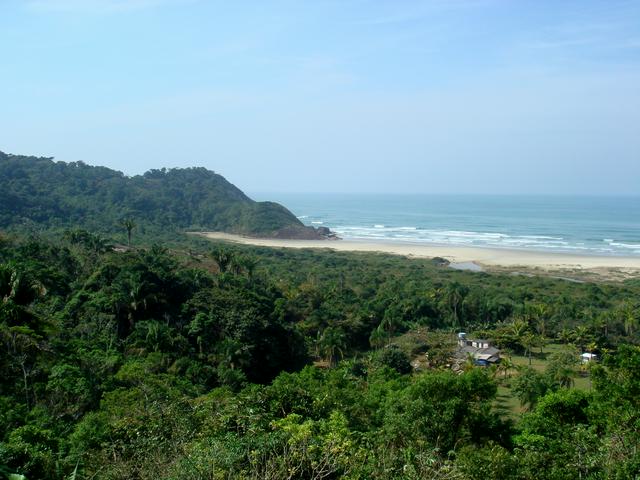Peruíbe is a city in the South Coast region of São Paulo state.
Peruíbe in the Tupi language means river of the shark. Originally as the region of Mongaguá, Peruibe belonged to the Itanhaém territory that stretched from São Vicente to Cananeia, both Portuguese villages founded during the colonial times. Back in the 16th century, the region of Peruibe (and the one of Itanhaém) would have had a bad reputation since most Tupiniquim Indians living there were put into slavery by the Portuguese, working in sugarcane plantations around Saint Vincent. The Abarebebe as the Indigenous peoples called Father Leonardo Nunes, or "the priest that flies" – since he was seen frequently walking on foot all around the long beach between Itanhaem and Peruibe, was the one who fought against this practice that hurt so many Indian families. He even converted an Indian Chaser who was then killed by the Indians, dying as a martyr. It was there, on the rock of Abarebebe that the Jesuits (also Father Joseph of Anchieta) built the first church of that part of the coast, named Church of Saint John Baptist that served also as a school and refuge against the Indian attacks. The sacred objects were taken to Itanhaem when its first church was finished a little later. Nowadays Peruibe is a modern city with many high-class boroughs and restaurants. The public interest in the city is rising since there is a nature reserve named Parque da Juréia (Jureia Natural Park), featuring pristine beaches (Prainha, Guarau, Parnapoa or Parnapuã, Juquiazinho, Baleia, Praia Preta, Desertinha, Carambore and Barra do Una), which is also a "local caiçara" (native) community of fishermen, sheltering also a immense diversity of flora and fauna. The city is surrounded by the Sea Mountain Range (Serra do Mar) the south end of which, near Barra do Una, is called Jureia Mountain Range.

- Abarebebê Ruins, access via Avenida Padre Anchieta (8 km from town. 8:30AM-5:30PM. The ruins of what has been identified as the first church to be built anywhere in Brazil, constructed of clay and stone by the Jesuits in the 16th century.
- Archeological Museum.
- Black mud. The unique mineral-rich mud found here has been used for centuries for its supposed medicinal properties.
- Mosaic Chapel, Avenida Darcy Fonseca, 181 - Jardim dos Prados, +55 13 3458-1717.
- Juréia-Itatins Ecological Station.
- Peruíbe Aquarium, Av. Governador Mario Covas Jr., 205, +55 13 3453-1568. Tues-Sat 12AM-6PM, Sat and holidays 10AM-8PM, Sun 10AM-6PM. A small aquarium, a nice stop if you have kids in tow. Adults R$5, kids 2-12 and seniors $R3..
- Rio Preto Bridge.
- TV Tower Lookout. A radio tower on a hill offers a panoramic view of the area.
- Cachoeira das Antas.
- Cachoeira do Perequê.
- Cachoeira do Paraíso.
Cachoeira das Antas.
Cachoeira do Perequê.
Cachoeira do Paraíso.
Abarebebê Ruins, access via Avenida Padre Anchieta (8 km from town. 8:30AM-5:30PM. The ruins of what has been identified as the first church to be built anywhere in Brazil, constructed of clay and stone by the Jesuits in the 16th century.
Archeological Museum.
Black mud. The unique mineral-rich mud found here has been used for centuries for its supposed medicinal properties.
Mosaic Chapel, Avenida Darcy Fonseca, 181 - Jardim dos Prados, +55 13 3458-1717.
Juréia-Itatins Ecological Station.
Peruíbe Aquarium, Av. Governador Mario Covas Jr., 205, +55 13 3453-1568. Tues-Sat 12AM-6PM, Sat and holidays 10AM-8PM, Sun 10AM-6PM. A small aquarium, a nice stop if you have kids in tow. Adults R$5, kids 2-12 and seniors $R3..
Rio Preto Bridge.
TV Tower Lookout. A radio tower on a hill offers a panoramic view of the area.

The most frequented and most easily accessible beaches are:
- Guaraú. Perhaps the most beautiful beach in the area. Bounded on the south by the river of the same name.
- Praia do Centro. A very wide flat beach. The rock outcropping on the south end separate it from the smaller Costão Beach.
There are many other beaches in the area, many of which can only be reached by trails which start near the highway, such as Praia do Índio and Prainha. A number of beaches south of Guaraú are striking in their beauty but fall within the bounds of Itinguçu State Park can only be visited with the accompaniment of a licensed environmental monitor. For more information, call the Peruíbe Association of Environmental Monitors (AMAP) at (13) 9701 3428 (Portuguese only).
Guaraú. Perhaps the most beautiful beach in the area. Bounded on the south by the river of the same name.
Praia do Centro. A very wide flat beach. The rock outcropping on the south end separate it from the smaller Costão Beach.
- Praça Ambrósio Baldin. Better known to locals as Praça Redonda, this plaza has over 80 stalls selling jewelry, handicrafts, clothes, and many types of food.
- Praça Florida, Avenida Padre Anchieta, +55 13 3453-1359. Around 25 arts and crafts stall plus a food court under a permanent roof structure.
Praça Ambrósio Baldin. Better known to locals as Praça Redonda, this plaza has over 80 stalls selling jewelry, handicrafts, clothes, and many types of food.
Praça Florida, Avenida Padre Anchieta, +55 13 3453-1359. Around 25 arts and crafts stall plus a food court under a permanent roof structure.
- Armazém, Rua dos Expedicionários, 640 (Center, +55 13 3455-2530. Buffet-style mineira cuisine.
- O Gordo, Avenida Padre Anchieta, 6673 (Arpoador, +55 13 3456-3233. A La Carte style.
Armazém, Rua dos Expedicionários, 640 (Center, +55 13 3455-2530. Buffet-style mineira cuisine.
O Gordo, Avenida Padre Anchieta, 6673 (Arpoador, +55 13 3456-3233. A La Carte style.
- Hangar Chopperia, Avenida Padre Anchieta, 1673 – Stella Maris, +55 13 9724-2814.
- Canopy Bar, Av. Padre Anchieta, 4691 - Três Marias, +55 13 3458 4505.
Hangar Chopperia, Avenida Padre Anchieta, 1673 – Stella Maris, +55 13 9724-2814.
Canopy Bar, Av. Padre Anchieta, 4691 - Três Marias, +55 13 3458 4505.
